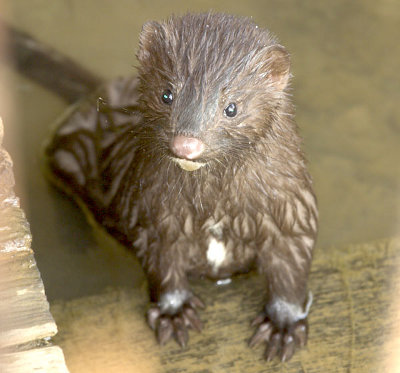Mink
Category: North American Mammals

Facts about Minks, Scientific name for Mink is Neovison vison" The "mink" is a semi-aquatic and carnivorous mammal that is highly endangered species. There are four species of the Mink and they include the following:
Mustela vision
Mustela lutreola
Mustela macrodon and
Mustela vison evergladensis.
The mink belongs to the Animalia kingdom; in the Mammalia class; Mustela genus and the Mustelidae family.
Otters and polecats belong to the same family as the minks.
Due to the mink’s highly prized quality fur, the species is farmed in large scale. The Mink is for this same reason that the species is highly endangered. The Mink fur is used in making fashionable clothing that are in high demand.
The mortality rate for the mink is very high but those that survive their first year after birth can live for up to three years in the wild. However, in captivity the Mink does very well and can live for ten to twelve years. At the same time in captivity the mink can only have four to five kits per litter annually.
Minks can live in rock holes, holly tree stumps and even in neglected muskrat dens. The Mink is quite wise and can stock up to one month’s food supply units at home. Minks hunt for food in the wild for continued survival. They are often known to prey more than they need so they hardly go without food. The Minks slender and tall bodies make it very easy for these mammals to access burrows as well as tunnels in search of food.
In terms of appearance minks look like big weasels or little otters. Minks largely dwell in swampy areas of Scotland, US and Britain. The American mink adapts to several other environmental conditions as compared to the European mink. The American minks are also larger than the European minks. Minks are about 12–18 in (30–45 cm) in body length, while females measure 11–15 in (27–37.5 cm). The male Minks tail measures 6–10 inches (15.6–24.7 cm) the female tails are 6–8 in (14.8–21.5 cm). Weights vary with season and sex, the males being heavier than females. In winter, males Minks weigh 1–3 lb (500–1,580 g) and females 1–2 1/2 lb (400–1133 g) the heaviest they are occurs in autumn.
On the other hand; the European mink has a large white patch on their upper lip which sometimes lacks in the American mink. The American and the European mink were initially classified under the same genus but recent development has seen the American mink re-classified to a different genus. Male minks live in relatively larger shelters as compared to female minks.
It is important to note that minks love watery environments and as such they will be found in ditches; streams and even along the seashore. Water supply is essential for their sustained survival.
Weather conditions are important in determining how minks shed their skin. In winter their skin become very thick and it is shed in spring and summer when the weather conditions pave way for warmth.
The Minks sense of smell is very strong and they can therefore smell their predators from a distance. As soon as the Mink sense danger they relocate to other habitats for safety. They have a unique anal gland that allows them to excrete a foul fume that helps distract invaders.
The mink being a semi-aquatic carnivore majorly feeds on fish, crustaceans, amphibians, small rodents and insects. The Mink diet is also highly determined by their ecological niche at a time. They primarily target voles and this has led to a great decline in the population of voles.

 Back To Category North American Mammals
Back To Category North American Mammals